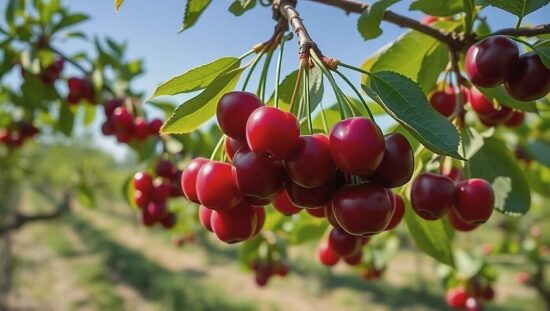Germany’s fruit growers have reported a strong cherry harvest for the summer of 2025. According to final estimates released Monday by the Federal Statistical Office (Destatis), a total of 47,100 metric tons of cherries were harvested. This breakdown includes 79% – or 37,300 tons – of sweet cherries and 21% – or 9,800 tons – of sour cherries.
The 2025 harvest represents a 4.2% increase compared to the ten-year average from 2015 to 2024, which stood at 45,200 tons. The figure also marks a significant improvement over the 35,400 tons harvested in 2024, representing an increase of 11,700 tons, or an impressive 33.1%.
The final estimate for sweet cherry production reached 37,300 tons – a 9,400-ton, or 33.6%, gain over the markedly lower yield of the previous year, which was impacted by weather conditions. Compared to the ten-year average of 32,900 tons, growers achieved a gain of 4,400 tons, or a 13.3% increase. Favorable weather during the flowering period, coupled with the avoidance of damaging frost and hail events in most growing regions, contributed to the successful sweet cherry harvest.
Sweet cherries are cultivated across 5,700 hectares in Germany. Baden-Württemberg accounts for the largest area, with 2,600 hectares dedicated to their cultivation. The region produced 17,600 tons of sweet cherries, representing 47% of the nation’s total. Lower Saxony follows, with 5,000 tons harvested from 480 hectares. Although Rhineland-Palatinate (660 hectares) and Bavaria (540 hectares) have larger areas dedicated to sweet cherries, their harvests yielded 3,700 and 1,800 tons respectively.
While Baden-Württemberg experienced a slight decrease of 250 tons (-1%) compared to the prior year, Lower Saxony saw a substantial increase of 2,000 tons (+67%), mirroring gains in Rhineland-Palatinate (+76%) and Bavaria (+30%). These regional differences are attributable to Baden-Württemberg’s exceptionally high yield in 2024, while other regions faced considerable weather-related losses.
The final estimate for sour cherry production totaled 9,800 tons, surpassing the extremely low-yielding 7,500 tons of the previous year by 31.3%. Although an initial preliminary estimate in June projected 11,700 tons, nearing the ten-year average of 12,300 tons, the final harvest ultimately fell 20.0% below. The lower figures are also linked to a reduction in planted area for sour cherries, decreasing from 2,000 hectares to 1,500 hectares (-25%).
Rhineland-Palatinate maintains the largest area dedicated to sour cherry cultivation, with 460 hectares, followed by Saxony (300 hectares) and Baden-Württemberg (240 hectares). Rhineland-Palatinate produced the highest harvest, with 2,700 tons (+40% compared to last year), followed by Thuringia (1,900 tons, +179%) and Saxony (1,800 tons, +1,249%). These dramatic year-over-year comparisons highlight the unusually challenging conditions faced by growers in 2024, particularly throughout eastern Germany, where nearly complete crop failures were reported in some regions.





